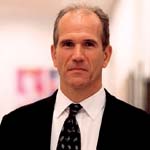Interview: Sandy Nairne
Sandy Nairne’s career in art began at Oxford where he ran the Oxford Students Arts Council


Sandy Nairne, the director of the National Portrait Gallery (NPG) since 2002, discovered his real interest in contemporary-art curating when an under-graduate at Oxford, but only after a year devoted to rowing (he s a rowing blue). My first year was dominated by rowing; the second by my running the Oxford Students Arts Council. There were lots of talented people around then in the 1970s, and we used a room over a garage. I had to persuade the owner not to tune up the cars when we were upstairs there was a bit of an issue with carbon-monoxide.
Two weeks after his finals, he bought a wooden punt. The river still plays a key part in his life and he competes regularly in a racing punt (only 2ft wide and 28ft long). He is a proud member of the Dittons Skiff and Punting Club. My son says punt racing is a sport bitterly contested by 17 people, which is very unfair. It goes back to the late 19th century.
Tall and dark-eyed, Mr Nairne can, in a crowd, seem a commanding, quiet presence, but, in conversation, he has an eager, quick-witted enthusiasm. He grew up near Cobham in Surrey, surrounded by woods to escape to. My father is a gifted amateur watercolourist, and I loved walking with him, sketchbook in hand. His father, Sir Patrick Nairne, was a senior civil servant and master of St Catherine s College, Oxford. After university, Mr Nairne joined Nicholas Serota at the tiny Museum of Modern Art in Oxford. I was assistant director, but there were only four staff. It was a great apprenticeship, and Nick was clearly someone who was going to go places.
He went to the Tate Gallery next, and worked as an assistant keeper with Richard Morphet, a brilliant man. I was surprised to get the job there as I wasn t an art historian, but I think they needed people with managerial experience . In 1980, he went on to become director of exhibitions at the Institute of Contemporary Arts (ICA).With Mr Serota, who was then director of the White-chapel Art Gallery, he curated a show of 20th-century British sculpture in 1981. Then, having worked at the Arts Council, he joined Mr Serota again at the Tate, in 1994: The great expansion of Tate Modern was about to happen they were very exciting times. Mr Nairne revels in the NPG. It was founded in the 19th century, influenced by Thomas Carlyle s idea that a portrait was a candle by which a bio-graphy for the first time can be properly read , and, although perhaps not so explicitly, by the Victorian spirit of emulation and self-improvement.
The NPG still commissions five or six special portraits a year of leading national figures current subjects include Sir Peter Mansfield, inventor of the MRI scanner. The trust-ees decide who the sitters will be, and then delegate to me the choice of artist. Sarah Howgate, our contemporary curator, does much of the hard work. The photographic collections continue to expand. Indeed, the blockbuster exhibition this year, Vanity Fair Portraits (until May 26), is of photographs. Mr Nairne is keen to promote a high standard of research as a way for a national institution to fulfil its public role: We have eight million visitors to our website each year, and they have access to all the results.
Mr Nairne feels that the NPG is in good form at the moment, and he s very cheerful , having just received a substantial gift of £5 million over three years, from US donor Randy Lerner (who owns Aston Villa football club) in memory of his father. Half of this is to be devoted to the portrait fund. This is after another major donation from Sir Christopher Ondaatje. And what is the state of British portraiture? Oh, I think it s in fighting form. The truth is that, although Modernism seemed to turn away from subject pictures, nearly all the major modern-art movements include portraiture in some way. Most contemporary art is about identity, and you have to remember that this is a museum about people first and foremost.
Exquisite houses, the beauty of Nature, and how to get the most from your life, straight to your inbox.
Country Life is unlike any other magazine: the only glossy weekly on the newsstand and the only magazine that has been guest-edited by His Majesty The King not once, but twice. It is a celebration of modern rural life and all its diverse joys and pleasures — that was first published in Queen Victoria's Diamond Jubilee year. Our eclectic mixture of witty and informative content — from the most up-to-date property news and commentary and a coveted glimpse inside some of the UK's best houses and gardens, to gardening, the arts and interior design, written by experts in their field — still cannot be found in print or online, anywhere else.
